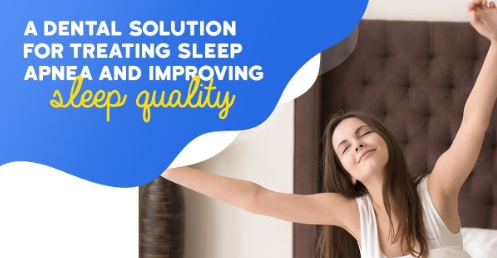How Dentistry Plays a Role in Managing Sleep Apnea
A good night’s rest can feel like a distant dream for many. If you or your partner consistently struggle with loud snoring, daytime exhaustion, and restless nights, you might be dealing with more than just poor sleep habits. These are common signs of sleep apnea, a serious condition that affects over 22 million Americans. While many associate sleep apnea treatment with cumbersome CPAP machines and sleep specialists, a crucial and often overlooked ally in this fight is your dentist.
Many people are surprised to learn that their dentist can be one of the first lines of defense against sleep apnea. At the Advanced Center for Cosmetic Dentistry, Dr. Roberto Macedo and our team are committed to a holistic approach to patient care. We understand that your oral health is deeply connected to your overall well-being. During a routine dental exam, we can spot subtle signs of sleep-disordered breathing that might otherwise go unnoticed.
This post will explore the critical connection between dentistry and sleep apnea management. We’ll cover what sleep apnea is, how dentists can help identify it, and the effective, modern dental solutions available. If you’re searching for a path to better sleep and improved health, you might find the answer in an unexpected place: the dentist’s chair.
Understanding Sleep Apnea: Causes, Symptoms, and Risks
Before exploring the solutions, it’s important to understand the condition itself. Sleep apnea is a sleep disorder characterized by repeated interruptions in breathing during sleep. These pauses, called “apneas,” can last from a few seconds to over a minute and may occur hundreds of time a night. When breathing stops, the brain and body may not get enough oxygen, leading to significant health risks.
There are three main types of sleep apnea:
- Obstructive Sleep Apnea (OSA): This is the most common form. It occurs when the muscles in the back of the throat relax and fail to keep the airway open, leading to a physical blockage.
- Central Sleep Apnea (CSA): This type is less common and involves the brain. It happens when the brain fails to send the proper signals to the muscles that control breathing.
- Complex Sleep Apnea Syndrome: Also known as treatment-emergent central sleep apnea, this is a combination of both obstructive and central sleep apnea.
While the types differ, their symptoms often overlap. Recognizing these signs is the first step toward getting help.

Common Symptoms of Sleep Apnea
Many people with sleep apnea are unaware they have it. Often, a bed partner is the first to notice the signs. Key symptoms include:
- Loud, persistent snoring
- Episodes of stopped breathing during sleep (witnessed by another person)
- Gasping or choking for air during sleep
- Waking up with a dry mouth or sore throat
- Morning headaches
- Excessive daytime sleepiness (hypersomnia)
- Difficulty concentrating and irritability
Risk Factors for Sleep Apnea
Certain factors can increase your risk of developing sleep apnea. These include:
- Obesity: Excess weight is a major risk factor for OSA.
- Age: The risk increases as you get older.
- Neck Circumference: People with thicker necks may have narrower airways.
- Anatomy: A narrow throat, large tonsils, or a large tongue can obstruct the airway. The shape and size of your jaw also play a significant role.
- Family History: Having family members with sleep apnea may increase your risk.
- Lifestyle: Alcohol consumption, smoking, and the use of sedatives can worsen sleep apnea.
Untreated sleep apnea is more than just a nuisance; it poses serious health risks, including high blood pressure, heart disease, stroke, type 2 diabetes, and an increased risk of accidents due to daytime fatigue.
The Role of Dentists in Sleep Apnea Diagnosis
Your dentist sees you regularly and has a unique view of your oral and facial structures. This position allows them to spot potential signs of sleep apnea that you might not even realize are related. During a routine checkup, a dentist trained in dental sleep medicine can identify red flags.
Key indicators that dentists look for include:
- Evidence of Bruxism (Teeth Grinding): Many people with sleep apnea grind or clench their teeth at night. This can lead to worn-down, cracked, or chipped teeth. Your body may clench the jaw to prevent the airway from collapsing.
- Scalloped Tongue: When the tongue is too large for the mouth, it can press against the teeth, leaving indented, wavy marks along its sides. This can be a sign of an obstructed airway.
- Enlarged Tonsils or a Large Uvula: A physical examination can reveal tissues that may be blocking the back of the throat.
- A Narrow or “High-Arched” Palate: The shape of the roof of your mouth can indicate a smaller airway.
- Redness in the Throat: Chronic snoring and mouth breathing can cause inflammation and irritation in the throat tissues.
Dental X-rays, such as panoramic radiographs or cone-beam computed tomography (CBCT) scans, provide a detailed look at your jaw, teeth, and airway. These imaging tools can help a dentist visualize the size and shape of your airway and identify potential blockages.
If your dentist suspects you have sleep apnea based on these findings, they will not make a final diagnosis. Instead, they will collaborate with a sleep specialist. This typically involves referring you for a sleep study (polysomnogram), which is the gold standard for diagnosing sleep apnea. This partnership ensures you receive a comprehensive and accurate diagnosis.
Dental Solutions for Sleep Apnea: Oral Appliance Therapy
For years, the primary sleep apnea treatment for moderate to severe sleep apnea was the Continuous Positive Airway Pressure (CPAP) machine. This device uses a mask to deliver steady air, keeping the airway open during sleep. While effective, many found CPAP machines uncomfortable, noisy, and hard to travel with, leading to low compliance.
Fortunately, dentistry offers a highly effective alternative for many with mild to moderate obstructive sleep apnea: Oral Appliance Therapy (OAT).
Oral appliances are custom-fitted devices, like a mouthguard, worn only during sleep. They reposition your jaw or tongue to keep the airway open. There are two main types:
- Mandibular Advancement Devices (MADs): The most common type, MADs gently push the lower jaw forward. This tightens upper airway muscles and soft tissues, preventing obstruction.
- Tongue Retaining Devices (TRDs): These use suction to hold the tongue forward, preventing it from blocking the throat.
Benefits of Oral Appliance Therapy
For suitable candidates, oral appliances offer several advantages over CPAP therapy:
- Comfort: Custom-made for a perfect fit, they are far more comfortable than bulky masks.
- Portability: Small, compact, and easy to travel with, ensuring treatment can be maintained anywhere.
- Ease of Use: Simply insert before bed; no machines, hoses, or electricity are required.
- Quiet: Silent operation benefits both the patient and their bed partner.
- High Compliance: Comfort and convenience lead to consistent patient use.
Advanced Center for Cosmetic Dentistry’s Approach to Sleep Apnea Treatment
At the Advanced Center for Cosmetic Dentistry, we believe in a patient-first approach to sleep apnea treatment. Dr. Macedo utilizes cutting-edge technology combined with personalized care plans to achieve the best outcomes. During your initial consultation, we thoroughly assess your symptoms, medical history, and conduct an in-depth oral examination to establish the most effective course of treatment.
Advanced imaging techniques, such as CBCT scans, allow us to analyze your airway and facial structure with precision. If oral appliance therapy is a suitable option for you, we take accurate digital impressions of your teeth. These detailed impressions are sent to a specialized dental lab, ensuring a custom-fitted appliance that maximizes comfort and effectiveness.
Once your custom appliance is crafted, you’ll attend a fitting appointment, where Dr. Macedo adjusts the device for an optimal fit. You’ll receive instructions on proper use and care to ensure efficacy. Follow-up visits are scheduled to monitor progress and make adjustments, ensuring long-term success with your treatment.

The Connection Between Oral Health and Sleep Apnea
The relationship between sleep apnea and oral health is a two-way street. Not only can a dentist help identify sleep apnea, but untreated sleep apnea can also cause a host of dental problems. These include:
- Bruxism: As mentioned, teeth grinding is common in people with OSA and can lead to severe tooth wear, fractures, and jaw pain (TMJ disorders).
- Dry Mouth (Xerostomia): Mouth breathing during sleep dries out the oral tissues, reducing saliva flow. Saliva is crucial for neutralizing acids and washing away food particles. A lack of it increases the risk of tooth decay and gum disease.
- Increased Cavity Risk: The combination of dry mouth and fatigue (which can lead to poor oral hygiene habits) creates a perfect environment for cavities to develop.
Maintaining excellent oral hygiene is essential when undergoing sleep apnea treatment. At the Advanced Center for Cosmetic Dentistry, we provide guidance on how to protect your oral health, including tips for managing dry mouth and protecting your teeth from grinding.
Take the First Step Toward Better Sleep
If you or a loved one are struggling with the symptoms of sleep apnea, don’t wait to seek help. The consequences of inaction are too great. A visit to a dentist trained in sleep medicine can be a crucial first step on your journey to diagnosis and treatment.
At the Advanced Center for Cosmetic Dentistry, Dr. Roberto Macedo and our compassionate team are here to help. We can assess your risk, guide you toward an accurate diagnosis, and provide effective, comfortable treatment for sleep apnea with custom oral appliance therapy. It’s time to stop just dreaming of a good night’s sleep and start experiencing it.
Contact us today to schedule a consultation and learn how dental solutions can help you breathe easier, sleep better, and improve your overall health.
https://www.google.com/maps?cid=11223011915097161618
